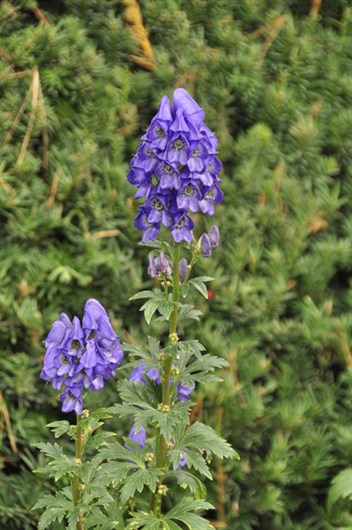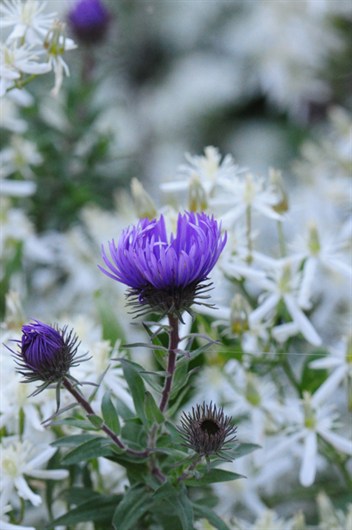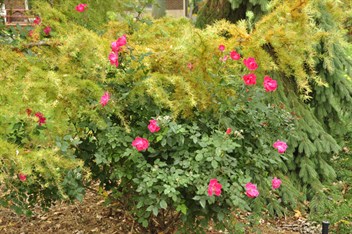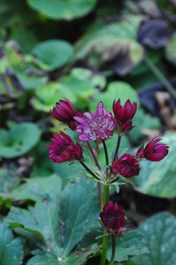In search of later perennials and partners
We know you're already making the most of fall leaf
color in the landscape. However, don't forget all the very late
flowers that call us out to enjoy the Indian Summer.
If a garden "falls" short in the bloom department, take stock of
its latest flowers so you can compare them to what others are
growing, place plants for most impact, and find what you need at
the garden center in spring.
Make notes
...because we can easily forget fall bloomers' importance over a
winter. By April, spring species dazzle us and leap onto our cart
at the garden center. Among the latest fall bloomers:
• Frost aster (Aster
pilosus/Symphyotrichum pilosum)
(more about
asters on our Aster page...),
• Fall fairy candle (Cimicifuga
ramosa/Actaea ramosa),
• Rough Joe Pye (Eupatorium
rugosum)
• Fall crocus (Crocus
kotschyanus)
• Montauk daisy (Nipponanthemum
nipponicum)
• ...and others pictured here.
This article is Sponsored by...
Left: Fall monkshood (Aconitum carmichaelii)
waits until October to open its vivid blue
flowers.
Patience, placement and pinches
Fall bloom in a perennial garden or mixed border
does require patience. We must plant this year for
next, since new perennials may take that long to hit
their stride. Then, every year we must predict each
plant's growth months ahead. What nearby plants will
be attractive when it blooms? Should we reduce its
spread with spring division, or delay its bloom with
a
midsummer pinch?
For instance, a mum
It's great for its bloom in late October. However,
many mums would flower in late August if left to
their
own devices. So we delay them with pinches --
shearing the plant's top in midsummer to make it
start
over with new buds.
We not only pinched the mums we have in mind to stall off their
bloom, we divided them in spring so they could not spread to their
full potential. That's because even though we say at bloom time,
"Wish we had more of that!" a mum is not a star deserving of the
room in spring and summer. Pre-bloom, it's more of a green
filler.
Then in fall we gave them one more boost. We selected
appropriate company by cutting this and not that near the mums as
we closed the garden at Halloween.
Below: A border before and after our fall cut. Mums can look
lonely in fall if we cut everything else. That's why we
deliberately left a few cold-tolerant petunias in place.

For example, two years' wait for a toadlily

This toadlily (Tricyrtis hybrid, right) is
beautiful this year. However, one year it ended its season
prematurely under the shears of a misguided gardener during a
September tidy-up mission. At cutting time it hadn't even begun its
month-long transformation from upright clump to gracefully
widespread stems gracefully, each leaf node ready to display its
orchid-like flowers.
Toadlily flowers develop best color and the foliage remains deep
green and unmarred when the plant's grown in a cool, moist place,
shaded during the hottest part of the day and surrounded by loose
soil to accept the running roots.

Salvia is a huge genus with plenty of red flowering
late bloomers -- most of them perennial but hardy only in zones 7
and warmer. Yet they're worth the space and the wait.
The red warmth in the background border (below, left) comes
from the bloom of tender, late blooming Salvias. They call
hummingbirds to one last feast before migrating.

Pretty faces need particular placement
Even the most dramatic flower
is prettier in good
company. Place them and tend the bed near them to
let them pose with cold tolerant annuals, as well as
perennials with an extended bloom season or a
tendency to rebloom after a summer cutback.
For instance, placed
with a backdrop:
Nerine bowdenii (below, left) has
contributed only foliage throughout summer, yet we give it front
row position. There, its pink flowers have better background from
dusty miller than they would if directly in front of the
brick.

For instance, tended to show off to the end
Asters are beautiful in fall. (Above, right, this
aster also benefits from a light colored backdrop.) The color
continues even as the blooms fade (below, left to right)
and sometimes a quick cold snap that stops petal-fall freeze-dries
the color to make it last even longer.



As we cut back in fall so we can see to weed and divide, we are
attuned to fitting companions for the asters. We preserve and cut
around those rather than cut them down. (Above, left: Leave the
evergeen bergenia foliage. Above, center and right: Cut down
everything but the asters and say "thanks" to the dark hedge
background.)
It's a line-up that changes every year based on what shapes and
foliage colors remain around the fall bloomer.
For example, giving cool colors a boost

Cool colors can be lost in fall's long shadows. The blue salvia
at right (annual Salvia farinacea) would be
wasted but for the backdrop of pale leaves from blue mist spirea
(Caryopteris 'Worcester Gold').
Shrubs are often the best backdrop for fall bloomers. The best
choices are evergreens and species that hold their leaves long into
fall then develop color complementary to the foreground
autumn bloomers.
Below, left: Fall colors of weeping larch needles
(Larix decidua 'Pendula') back up a rose's October
blooms.



Space is part of the picture
Garden space telescopes in late fall and winter. Our increasing
distance from the bed shrinks space. Where a dozen plants grew,
each distinct in summer, now our eye compresses such a spot and can
skip right past.
Above, right: Getting back to the border with the mum, shown
earlier, notice how that space telescopes in this season. Right:
We've cut away visually distracting plants in an eight foot stretch
beyond the mum (arrow). That space is barely a blink now even if it
would have generated a rumble in August, "What's that big bare
space?"
So in fall something 20' beyond a late bloomer can become its
immediate background. When we clip, fertilize, weed and mulch for
fall, we leave certain plants untouched even far behind and well in
front, if they add to the composition -- "behind" and "front"
defined by the indoor viewer's cold-weather angle of view.
Earlier work pays off
Some of the best companions for fall blooming plants are earlier
blooming species that extend their bloom if we deadhead, and those
that when cut back can be relied upon to develop fresh foliage and
a repeat bloom.

Masterworts (Astrantia species; here at right
A. rubra 'Rose Symphony') grow wonderfully in cool air and
some shade. This one puts on a show in June but often celebrates
the fall weather with more flowers. It's not only the blossoms but
the compact mound of neat foliage that complements the height and
sprawl of the season-end bloomers.

Japanese anemones will keep producing more buds
high on the flower stalks if individual blooms are
clipped off as they fade.
At left, Anemone x hybrida 'Whirlwind' is
still
producing new blooms in early November.
Below: By November, we're into our second month
of
deadheading and clipping fading foliage from the
Japanese anemones on the right. During all that time the
angel wing begonias to the
left have been effective, undemanding company. Now that
it's cut-down time, we
leave just a few begonias to accompany the
anemones.

Go and look
Gardens at friends' homes and in botanical gardens, arboretums
and public parks look good in to November. Take some walks there,
collecting ideas for what to plant for fall bloom and what to pair
it with.
Below: From friends you can copy a panicle hydrangea -
Japanese anemone border, or ask "Where did you get that tall, pink
cut-flower mum?!"


We're lucky enough to live near Windsor, in the Canadian
province of Ontario. That means a short trip across a river gives
us a look at ideas from a whole different region, influences coming
more from Toronto and Montreal than Chicago. For instance, in Windsor's Jackson Park at the Queen Elizabeth
II Sunken Gardens we see more mixed border combinations than at
home where perennials and annuals tend to be segregated.


It's also good to check out the gardens at your provincial
agricultural college or State land grant college (below,
Michigan State University's DeLapa Perennial Garden in late November, where
ornamental grasses, asters, turtlehead and winterberry glow).
Most have displays that look good in all four seasons. Take notes
or use your camera to record plant names and particular
varieties.

Below: In touring gardens we also take in what plants look
like in real life, as opposed to their marketing photos. We've
learned that late monkshood (Aconitum carmichaelii) does
indeed provide beautiful flowers in October, but its nether regions
may need camouflage unless the plant's grown where it's cool in
summer.


Sponsored by Mary Topf:

You, too can become a
Sponsor...
To read more of our Sponsor-recommended
articles